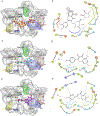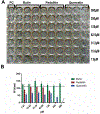Flavonoids from Pterogyne nitens as Zika virus NS2B-NS3 protease inhibitors
- PMID: 33636437
- PMCID: PMC8227833
- DOI: 10.1016/j.bioorg.2021.104719
Flavonoids from Pterogyne nitens as Zika virus NS2B-NS3 protease inhibitors
Abstract
Although the widespread epidemic of Zika virus (ZIKV) and its neurological complications are well-known there are still no approved drugs available to treat this arboviral disease or vaccine to prevent the infection. Flavonoids from Pterogyne nitens have already demonstrated anti-flavivirus activity, although their target is unknown. In this study, we virtually screened an in-house database of 150 natural and semi-synthetic compounds against ZIKV NS2B-NS3 protease (NS2B-NS3p) using docking-based virtual screening, as part of the OpenZika project. As a result, we prioritized three flavonoids from P. nitens, quercetin, rutin and pedalitin, for experimental evaluation. We also used machine learning models, built with Assay Central® software, for predicting the activity and toxicity of these flavonoids. Biophysical and enzymatic assays generally agreed with the in silico predictions, confirming that the flavonoids inhibited ZIKV protease. The most promising hit, pedalitin, inhibited ZIKV NS2B-NS3p with an IC50 of 5 μM. In cell-based assays, pedalitin displayed significant activity at 250 and 500 µM, with slight toxicity in Vero cells. The results presented here demonstrate the potential of pedalitin as a candidate for hit-to-lead (H2L) optimization studies towards the discovery of antiviral drug candidates to treat ZIKV infections.
Keywords: Antiviral; Drug discovery; Emerging arboviruses; Enzyme inhibitors; Flavonoid; NS3 protein; Protease; Pterogyne nitens; Virtual screening; Zika virus.
Copyright © 2021 Elsevier Inc. All rights reserved.
Conflict of interest statement
Declaration of Competing Interest
SE is founder and owner of Collaborations Pharmaceuticals, KMZ is an employee of Collaborations Pharmaceuticals, Inc. The remaining authors declare that there are no conflicts of interest.
Figures




Similar articles
-
Discovery of New Zika Protease and Polymerase Inhibitors through the Open Science Collaboration Project OpenZika.J Chem Inf Model. 2022 Dec 26;62(24):6825-6843. doi: 10.1021/acs.jcim.2c00596. Epub 2022 Oct 14. J Chem Inf Model. 2022. PMID: 36239304 Free PMC article.
-
Structure-activity relationship of flavonoid bifunctional inhibitors against Zika virus infection.Biochem Pharmacol. 2020 Jul;177:113962. doi: 10.1016/j.bcp.2020.113962. Epub 2020 Apr 6. Biochem Pharmacol. 2020. PMID: 32272109
-
The GA-Hecate Peptide inhibits the ZIKV Replicative Cycle in Different Steps and can Inhibit the Flavivirus NS2B-NS3 Protease after Cell Infection.Protein Pept Lett. 2024;31(7):532-543. doi: 10.2174/0109298665308871240703090408. Protein Pept Lett. 2024. PMID: 39039677
-
NS2B-NS3 protease inhibitors as promising compounds in the development of antivirals against Zika virus: A systematic review.J Med Virol. 2022 Feb;94(2):442-453. doi: 10.1002/jmv.27386. Epub 2021 Oct 20. J Med Virol. 2022. PMID: 34636434
-
The Structure of the Zika Virus Protease, NS2B/NS3pro.Adv Exp Med Biol. 2018;1062:131-145. doi: 10.1007/978-981-10-8727-1_10. Adv Exp Med Biol. 2018. PMID: 29845530 Review.
Cited by
-
Boroleucine-Derived Covalent Inhibitors of the ZIKV Protease.ChemMedChem. 2023 Feb 1;18(3):e202200336. doi: 10.1002/cmdc.202200336. Epub 2022 Nov 21. ChemMedChem. 2023. PMID: 36325810 Free PMC article.
-
Flavivirus proteases: The viral Achilles heel to prevent future pandemics.Antiviral Res. 2023 Feb;210:105516. doi: 10.1016/j.antiviral.2022.105516. Epub 2022 Dec 29. Antiviral Res. 2023. PMID: 36586467 Free PMC article. Review.
-
Discovery of New Zika Protease and Polymerase Inhibitors through the Open Science Collaboration Project OpenZika.J Chem Inf Model. 2022 Dec 26;62(24):6825-6843. doi: 10.1021/acs.jcim.2c00596. Epub 2022 Oct 14. J Chem Inf Model. 2022. PMID: 36239304 Free PMC article.
-
Structure and Dynamics of Zika Virus Protease and Its Insights into Inhibitor Design.Biomedicines. 2021 Aug 19;9(8):1044. doi: 10.3390/biomedicines9081044. Biomedicines. 2021. PMID: 34440248 Free PMC article. Review.
-
Natural Products and Derivatives as Potential Zika virus Inhibitors: A Comprehensive Review.Viruses. 2023 May 20;15(5):1211. doi: 10.3390/v15051211. Viruses. 2023. PMID: 37243296 Free PMC article. Review.
References
Publication types
MeSH terms
Substances
Grants and funding
LinkOut - more resources
Full Text Sources
Other Literature Sources
Medical
Research Materials

